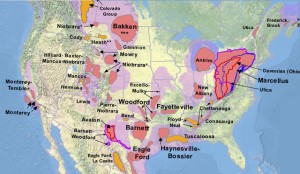WASHINGTON — Environmental problems with shale gas extraction can and should be managed, the former head of Pennsylvania’s Department of Environmental Protection told U.S. senators this week.
Kathleen McGinty, now a vice president heading clean energy development for Weston Solutions, is part of a Department of Energy advisory board that is calling both for more extensive measurement of environmental impact from gas well development and for a clearinghouse to share best practices between states familiar with gas production and those relatively new to the process.
Shale gas and exploration activities have increased dramatically in recent years. The technique of combining deep horizontal drilling with hydraulic fracturing, or “fracking,” allows access to what President Barack Obama has deemed a 100-year supply. In the process, water and sand under pressure are forced down wells and out horizontal legs to expand cracks in low-permeability shale, releasing trapped gas.
But as companies race to grab land and frack new wells, complaints of adverse environmental effects have surfaced, from methane in drinking water to people getting sick near drilling activities, according to published reports. The U.S. Environmental Protection Agency is studying the issue but does not expect to release a report on it until 2014.
In March, Obama ordered the Department of Energy to review ways to reduce environmental impact from shale gas extraction processes that include hydraulic fracturing and to report every three months.
Most of the environmental damage from shale gas extraction occurs from aspects other than the fracking process, such as concrete seals failing or spills on the surface, members of the advisory board said. A blown coupling at a well in Western Pennsylvania released more than 10,000 gallons of fracking liquid to a pasture and stream in April, according to the Pennsylvania Department of the Environment.
“Shoddy shale operations can adversely impact water quality,” McGinty told the Senate Energy and Natural Resources Committee on Tuesday. “Yet, fracturing per se seems not to be the culprit.”
Environmental problems are more likely associated with poor well construction, according to advisory board member Mark Zoback, a geophysics professor at Stanford University and advisor to Backer Hughes, which offers services related to shale gas production. Building secure wells using the best-known techniques is crucial to avoiding contamination in shallower aquifers, Zoback told the committee.
Most of what goes into a well during fracking is water and sand; the other components are gelling agents such as gaur gum, surfactants similar to dish soap and bleach, said advisory board member Stephen Holditch, professional engineer and department head at Texas A&M University.
“They’re really not all that dangerous on their own,” he told the Senate members.
But companies disclosed using known toxic contaminants including toluene, ethylbenzene and xylene in fracturing fluid, the Pennsylvania Department of Environmental Protection reported last year. The use of diesel fuel in the fluid had been discontinued in the state, according to the department.
Through the fracturing process, additional toxins including heavy metals from the gas and shale layers can be absorbed into the fracturing fluid, some of which can return to the surface, advisory board members said.
Companies should report specific quantities and concentrations of the various chemicals that are injected and extracted from every well, searchable on the Internet by company, location and compound, the board recommended.
“We need to be collecting the information on what goes into the ground and what comes out of the ground,” Holditch said. “More than likely there won’t be issues, but if there are issues we’ve measured them and we can fix them.”
State control was important to several senators, including Republican Sen. John Hoeven of North Dakota, which has major shale gas reserves.
“Explain to me with these recommendations how we walk this forward in a way the states stay primary regulators,” said Hoeven, a former governor.
The board said that state governments are best situated to deal with the varied geologic conditions across areas of the country with shale gas reserves and that they are closer to the individual communities. They did not find that an actor was missing from the regulatory scene, McGinty said.
“We did not reach any conclusion like that,” she said. The group’s recommendations were about “continuous improvement that is always needed to ensure the public’s confidence and to ensure that the industry is in fact moving forward in a responsible way,” she said.

